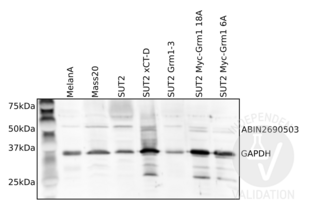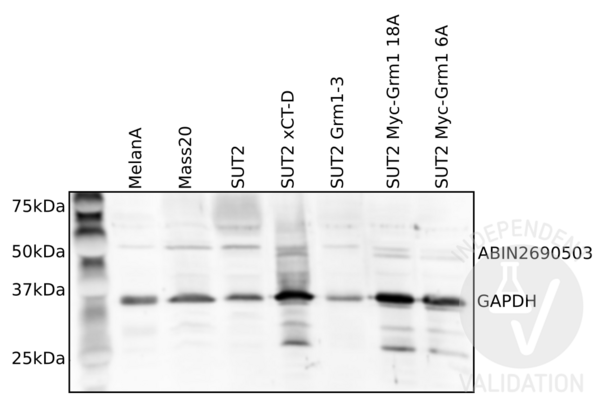SLC1A3 Antikörper

 SLC1A3 Antikörper (Cytoplasmic Domain) (ABIN2690503)
SLC1A3 Antikörper (Cytoplasmic Domain) (ABIN2690503)
SLC1A3 Reaktivität: Human, Ratte, Maus WB, IHC, ICC Wirt: Kaninchen Polyclonal unconjugated
SLC1A3 Reaktivität: Human, Ratte WB, ELISA, FACS, IF (cc), IF (p), IHC (p), IHC (fro) Wirt: Kaninchen Polyclonal unconjugated
SLC1A3 Reaktivität: Human, Ratte, Maus WB, IHC (p) Wirt: Kaninchen Polyclonal unconjugated
SLC1A3 Antikörper nach Grade
Hier sind SLC1A3 Antikörper mit einem spezifischen Grade zu finden. Die hier aufgeführten Grade sind einige der verfügbaren. Ein Klick auf den entsprechenden Link führt zu den Produkten.
SLC1A3 Antikörper nach Reaktivität
Hier sind SLC1A3 Antikörper für eine Vielzahl von Species wie anti-Human SLC1A3, anti-Rat SLC1A3, anti-Mouse SLC1A3 zu finden. Die unten aufgeführten Species gehören zu den verfügbaren Arten. Klicken Sie auf einen Link, um zu den entsprechenden Produkten zu gelangen.
SLC1A3 Antikörper nach Anwendung
Hier sind SLC1A3 Antikörper zu finden, welche für eine bestimmte Anwendung wie WB, ELISA, FACS, IHC validiert wurde. Einige der verfügbaren Anwendungen sind unten aufgeführt. Klicken Sie auf einen Link, um zu den entsprechenden Produkten zu gelangen.
SLC1A3 Antikörper nach Wirt
Hier sind SLC1A3 Antikörper mit einem spezifischen Wirt zu finden. Die hier aufgeführten Wirt sind einige der verfügbaren. Ein Klick auf den entsprechenden Link führt zu den Produkten.
SLC1A3 Antikörper nach Klonalität
Finden Sie verfügbare monoklonale oder polyklonale SLC1A3 Antikörper. Klicken Sie auf einen Link, um zu den entsprechenden Produkten zu gelangen.
SLC1A3 Antikörper nach Klon
Hier sind SLC1A3 Antikörper mit einem spezifischen Klon zu finden. Die hier aufgeführten Klon sind einige der verfügbaren. Ein Klick auf den entsprechenden Link führt zu den Produkten.
Häufig verwendete SLC1A3 Antikörper
- (3)
- (1)
- (2)
- (3)
- (1)
- (4)
- (3)
- (3)
- (2)
- (3)
- (4)
- (2)
- (1)
- (1)
- (1)
- (1)
- (1)
- (2)
- (1)
- (1)
- (1)
- (1)
Aktuelle Publikationen für unsere SLC1A3 Antikörper
: "Genetic ablation of Gpr37l1 delays tumor occurrence in Ptch1+/- mouse models of medulloblastoma." in: Experimental neurology, Vol. 312, pp. 33-42, (2019) (PubMed).: "Single-Cell Transcriptomics Uncovers Glial Progenitor Diversity and Cell Fate Determinants during Development and Gliomagenesis." in: Cell stem cell, Vol. 24, Issue 5, pp. 707-723.e8, (2019) (PubMed).
: "Chronic hyperammonemia alters extracellular glutamate, glutamine and GABA and membrane expression of their transporters in rat cerebellum. Modulation by extracellular cGMP." in: Neuropharmacology, (2019) (PubMed).
: "Quantification of brain-derived extracellular vesicles in plasma as a biomarker to diagnose Parkinson's and related diseases." in: Parkinsonism & related disorders, Vol. 61, pp. 82-87, (2019) (PubMed).
: "Depletion of microglia augments the dopaminergic neurotoxicity of MPTP." in: FASEB journal : official publication of the Federation of American Societies for Experimental Biology, Vol. 32, Issue 6, pp. 3336-3345, (2018) (PubMed).
: "Evaluating Synthetic Activation and Repression of Neuropsychiatric-Related Genes in hiPSC-Derived NPCs, Neurons, and Astrocytes." in: Stem cell reports, Vol. 9, Issue 2, pp. 615-628, (2018) (PubMed).
: "A neuroprotective astrocyte state is induced by neuronal signal EphB1 but fails in ALS models." in: Nature communications, Vol. 8, Issue 1, pp. 1164, (2018) (PubMed).
: "Exercise-Mediated Increase in Nigral Tyrosine Hydroxylase Is Accompanied by Increased Nigral GFR-α1 and EAAC1 Expression in Aging Rats." in: ACS chemical neuroscience, Vol. 7, Issue 2, pp. 227-39, (2016) (PubMed).
: "Decreased protein S-palmitoylation in dorsolateral prefrontal cortex in schizophrenia." in: Schizophrenia research, Vol. 177, Issue 1-3, pp. 78-87, (2016) (PubMed).
: "Oct4 Methylation-Mediated Silencing As an Epigenetic Barrier Preventing Müller Glia Dedifferentiation in a Murine Model of Retinal Injury." in: Frontiers in neuroscience, Vol. 10, pp. 523, (2016) (PubMed).
Aliase für SLC1A3 Antikörper
Excitatory amino acid transporter 1 (Eaat1) Antikörpersolute carrier family 1 member 3 (SLC1A3) Antikörper
excitatory amino acid transporter 1 (PTRG_00379) Antikörper
excitatory amino acid transporter 1 (Tsp_02392) Antikörper
solute carrier family 1 (glial high affinity glutamate transporter), member 3a (slc1a3a) Antikörper
solute carrier family 1 member 3 (Slc1a3) Antikörper
solute carrier family 1 (glial high affinity glutamate transporter), member 3 (Slc1a3) Antikörper
AF001784 Antikörper
AI504299 Antikörper
B430115D02Rik Antikörper
CG3747 Antikörper
dEAAT Antikörper
dEAAT1 Antikörper
dEaat1 Antikörper
Dglt-1 Antikörper
Dglut-1 Antikörper
Dmel\\CG3747 Antikörper
EA6 Antikörper
EAAT Antikörper
EAAT1 Antikörper
Eaat1 Antikörper
GLAST Antikörper
GLAST-1 Antikörper
GLAST1 Antikörper
GLU-T Antikörper
GluT-1 Antikörper
Gmt1 Antikörper
MGluT1 Antikörper
slc1a3 Antikörper
SLC1A3 Antikörper
wu:fb98e05 Antikörper
wu:fd50b05 Antikörper
zgc:56661 Antikörper
zgc:77768 Antikörper
Haben Sie etwas anderes gesucht?
- SLC1A2 Antikörper
- SLC1A1 Antikörper
- SLC19A3 Antikörper
- SLC19A2 Antikörper
- SLC19A1 Antikörper
- SLC18A2 Antikörper
- SLC17A9 Antikörper
- SLC17A8 Antikörper
- SLC17A7 Antikörper
- SLC17A4 Antikörper
- SLC17A3 Antikörper
- SLC17A2 Antikörper
- SLC17A1 Antikörper
- SLC16A7 Antikörper
- SLC16A6 Antikörper
- SLC16A5 Antikörper
- SLC16A4 Antikörper
- SLC16A3 Antikörper
- SLC16A2/MCT8 Antikörper
- SLC16A14 Antikörper
- SLC1A4 Antikörper
- SLC1A5 Antikörper
- SLC1A6 Antikörper
- SLC1A7 Antikörper
- SLC20A1 Antikörper
- SLC20A2 Antikörper
- SLC22A1 Antikörper
- SLC22A11 Antikörper
- SLC22A12 Antikörper
- SLC22A13 Antikörper
- SLC22A14 Antikörper
- SLC22A15 Antikörper
- SLC22A16 Antikörper
- SLC22A17 Antikörper
- SLC22A2 Antikörper
- SLC22A23 Antikörper
- SLC22A24 Antikörper
- SLC22A25 Antikörper
- SLC22A3 Antikörper
- SLC22A4 Antikörper




